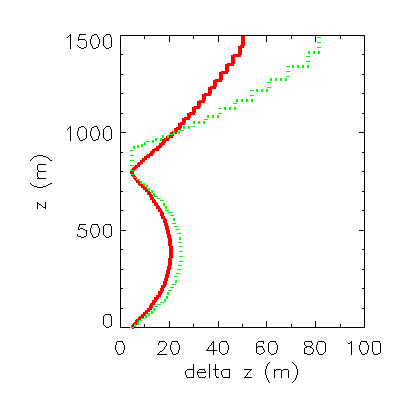DYCOMS-II Field Campaign
Ninth GCSS Boundary Layer Cloud Working Group Workshop
Revisions and Clarifications
9th GCSS BL Cloud Workshop HomeOverview
Setup
Output
Results
January 2005
Model Grid
Reworded the description to indicate that those using stretched grids should use the defined grid.
Initialization
Defined &thetal and qt. Recommended an expression for cloud droplet sedimentation.
Surface Fluxes
The description of surface fluxes has been rewritten to specify that the winds are locally defined.
Output Specification
Renamed scalar and profile variables ndrop to ndrop_cld to denote averaging over cloudy grid cells only. Added profile of cloud fraction.
March 2005
Initialization
The initial profiles are now given on the recommended grid (here). The air density units are kg/m3, not g/m3 as originally stated.
Radiation
The parameterized net radiative flux F is positive upwards, and thus the radiative heating rate is proportional to –dF/dz.
Surface Fluxes
The surface sensible heat flux should be evaluated at the surface instead of the mid-point of the bottom model layer, and thus psfc instead of p should appear in the denominator of the factor multiplying the surface temperature. This revision provides for an initial surface sensible heat flux that is independent of vertical grid resolution, and decreases the initial heat flux by 1.5% on the recommended grid (in which the mid-point of the first layer is at a height of 5 m).
Sponge Layer
The damping coefficient is a maximum of (100 s)-1, not 100 s-1, at the top of the domain. Also, in DHARMA we do not directly dampen vertical winds in the sponge layer.
Output Specification
Added the profile of rain water mixing ratio as a requested profile (for bin microphysics, use droplets greater than 25 μm radius). Clarified that the profile of condensed water mixing ratio should include cloud and rain water. For simulations without precipitation, the definition of cloudy grid cells translates to total water mixing ratio exceeding the saturation mixing ratio, equivalent to a condition of non-zero cloud water. For simulations with parameterized rain, unless a rain parameterization predicts a rain drop number concentration of 20 cm-3 (or more) in a grid cell, unsaturated grid cells should not be considered as cloudy. (If anyone's rain parameterization does give such high number concentrations of rain drops, that would be an unexpected result, so please mention it.) In my analysis I vertical interpolate zi between the grid cells where the threshold of 8 g/kg total water mixing ratio is crossed. For zb I am using the altitude of the bottom of the bottommost cloudy grid cell in each column. The time series of friction velocity should be extremely boring, with a constant value as specified for the surface fluxes. Supersaturation is the fractional relative humidity minus one, and it should be averaged over all grid cells, not just the cloudy ones. Resolved, not subgrid-scale, dissipation is requested.
April 2005
Initialization
Fixed an error at 797.5 m in the initial sounding.
Output Specification
Removed {sgs_shr}, subgrid-scale shear TKE production, from profiles.
June 2005 (post-workshop)
Model GridThose able to use a stretched grid should use 96 vertical grid points with Δz following a sin2 stretching within the boundary layer, a 125-m deep region with Δz = 5 m, and Δz increasing above, as seen below and computed in this Fortran source code.

|
Stretched vertical grid (red=original, green=revised) |
Initialization
The initial (and geostrophic) wind profiles have been revised:
| u = | 3 + 4.3 z / 1000 m/s |
| v = | –9 + 5.6 z / 1000 m/s |
Because of the changed winds, we are now translating the DHARMA domain at
5 and -5.5 m/s in the x and y directions, respectively
(this represents a change only for translation in the x direction).
Models using parameterized precipitation should specify a uniform cloud droplet concentration N = 55 cm-3, if possible.
Models that require CCN as input should use the same bimodal distribution as before, with the new caveat that the aerosol number concentrations in the two modes should be adjusted, through trial and error, to result in an average droplet concentration of N = 55 cm-3 in cloudy grid cells. It would be preferable to keep the total number of CCN fixed at 190 cm-3 when adjusting the numbers in the two modes; in practice it is unlikely that the CCN in the Aitken mode (the smaller mode) will ever be activated, so it is likely that the total number of CCN in the accumulation mode is all that matters.
Not a revision, but a reminder: models using predicted supersaturation to activate CCN should limit the maximum supersaturation used for droplet activation to not exceed 1% during the first hour of the simulation, which should result in activation of no more than 70 cm-3 droplets during that time. Note that this supersaturation limit should only be applied to droplet activation; the supersaturation used for condensational growth should not be restricted.
Surface Fluxes
The upward surface momentum fluxes should be
< w'ui' > = –ui u*2 /|U|
where the wind component ui and the magnitude of the horizontal wind |U| are defined locally, and the friction velocity is fixed at u* = 0.25 m/s.
The upward sensible and latent heat fluxes (separate from any precipitation flux) should be fixed at the measured values of 16 and 93 W/m2, respectively. A surface air density of 1.21 kg/m3 should be used to convert the surface heat fluxes into kinematic units.
Experiments
As before, we are requesting two six-hour simulations from each group: one with no sedimentation of condensed water, and one with precipitation (sedimentation of cloud water and drizzle drops). We additionally request optional simulations in which (i) only the sedimentation of cloud water is included in a simulation without drizzle, and (ii) the sedimentation of cloud water is omitted in a simulation with drizzle.

